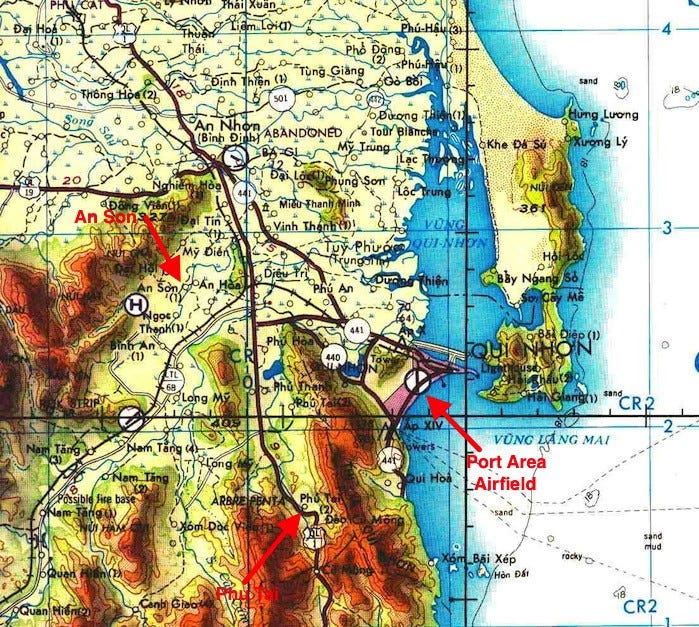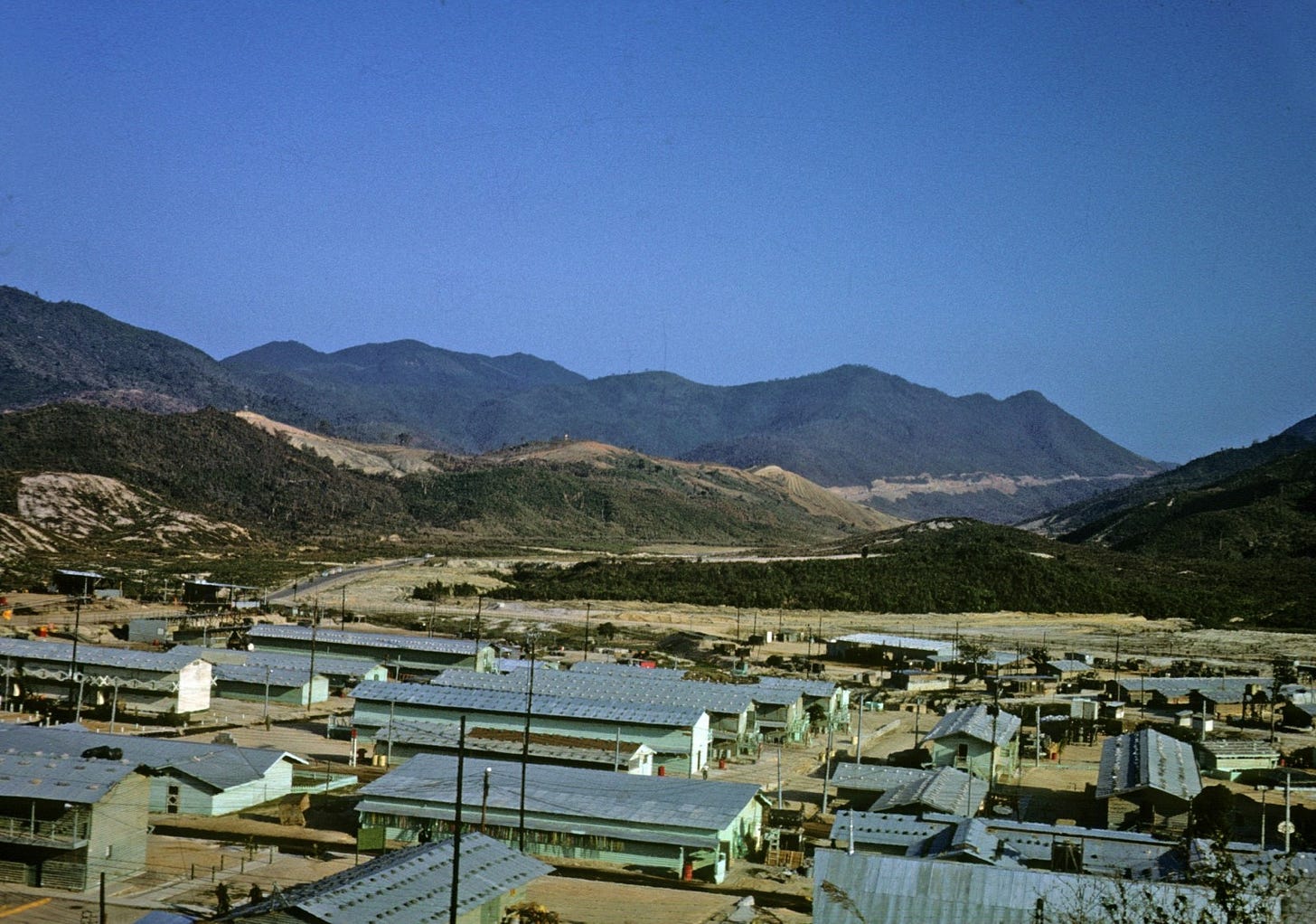Attacks on Qui Nhon Ammunition Base Depot (Vietnam) Virtual Staff Ride
Click on the photo to go through the Google Earth Slideshow.
The Qui Nhon Ammunition Base Depot is located in Valley "F” Phu Thanh, Republic of Vietnam. It is located at the northern base of Cu Mong Pass and is surrounded on four sides by higher ground.
To the north, there is a natural avenue of approach with a low ridgeline and dense vegetation.
To the east, there is a high ridgeline with extremely dense vegetation. On top of the ridgeline, there are several trails, but there are no streams or other sources of water resupply.
To the south is Cu Mong Pass, which is protected by 7th Company, 2nd Battalion, 26th Regiment, ROKA Capitol Division (Tiger).
To the west are high hills with extremely dense vegetation, numerous valleys, well-used trails, and sufficient streams to provide a resupply of water.
During 23 February - 23 March 1969, the Ammunition Base Depot at Qui Nhon sustained three sapper attacks by an unknown-sized hostile force. The attacks were all detected by an explosion in the depot area, and contact had never been made with a hostile force in the depot area.
On 23 February 1969, an unknown-sized enemy sapper unit attacked the Qui Nhon Ammunition Base Depot. The unit infiltrated the depot, set their charges on pads 92, 95, and 103 in the northeast area, and left it undetected. The three pads, which were satchel-charged, contained 105mm HE rounds.
On 10 March 1969, a sapper unit attacked the Qui Nhon Ammunition Base Depot a second time. The unit entered the depot in the northeastern perimeter area, placed satchel charges on three pads, and left the depot area without being detected. The first explosion was on Pad 89, which contained 105mm illumination rounds. Pad 23 contained 81mm HE mortars ammunition, and pad 90 contained 2.75-inch rockets. On 23 March 1969, a sapper unit again entered the depot and placed satchel charges on pads 76 and 64.
As a result of these attacks, the 184th Ordnance Battalion (Ammo) received the following casualties: 3 Missing in Action and Presumed Dead, 8 Wounded as a result of Hostile Action. The three attacks destroyed 23 pads and one small arms area, and one pad was damaged.
Recommendations
When troop level is maintained at reduced strength, consideration should be given to decreasing the number of separate units so that average output per man is not reduced.
That RVN [Republic of Vietnam] orientation given to personnel assigned to Vietnam with logistic MOSs emphasizes defense against sappers.
Fire trucks and all currently authorized fire fighting equipment should be made available to ammunition units in the field.
An alternate gate should be constructed, providing access to Highway 1 at a distance from the existing gate. This gato should be constructed so that it can be looked at, trip flared, and equipped with concertina barriers, yet easily opened when required.
A system of audio and visual signals should be devised and disseminated for use in the event of fire, attack, or evacuation. An audio and visual system would be devised utilizing sirens and flares that would supplement the normal communications channels to ensure the rapid dissemination of emergency information.
Conclusion
In unforgiving combat operations, ammunition supply points (ASPs) are critical for troops on the front lines. The attacks on the Qui Nhon Ammunition Base Depot in the Vietnam War offer valuable lessons that continue to be relevant in modern warfare, especially concerning ammunition storage and security. The attacks, carried out by trained enemy sappers, highlight the vulnerability of ammunition depots to infiltration and sabotage. Modern forces employ multi-layered security, including advanced surveillance systems, better perimeter defenses, and potentially even biometric identification systems to restrict unauthorized access.
However, their very purpose - storing explosives - makes security paramount. The ideal ASP is tucked away in concealing terrain, making it a difficult target and strategically positioned for easy defense. In hindsight, the vulnerability is seen in the valley location. Modern forces strive for a balance, ensuring sufficient personnel for robust security while maintaining operational efficiency. Ultimately, a successful ammunition supply point achieves a delicate balance: keeping ammunition out of enemy hands while ensuring the safety of explosives.
Additional Links
The link to the full Operational Report - Lessons Learned, Headquarters, 184th Ordnance Battalion, Period Ending 30 April 1969, can be seen Here.
The link to the Google Earth SlideShow (Virtual Staff Ride) can be seen Here.
Figure 1. Qui Nhon Region
Figure 2. 184th Ordnance Battalion base, 1967 (Andy Raggedy)
Figure 3. Depot Map
Figure 4. A South Guard Tower at 75% completion on 15 June 1966.
Figure 5. Remains of an ammo pad in the 184th depot following an attack (Andy Raggedy).
Figure 6. Mass Denition 105mm Rounds high-explosives artillery rounds litter Qui Nhon Ammunition Dump after Viet Cong Attacks.
References
A War Story and Cautionary Tale
https://biglittlemeals.com/a-war-story-and-cautionary-tale/
Qui Nhon Detachment "B"
https://720mpreunion.org/history/project_vietnam/212th/detachments/Qui_Nhon/Qui_Nhon.html
Vietnam Logistics: Qui Nhon
https://www.facebook.com/watch/?v=348342829724006
Lessons Learned, Headquarters, 184th Ordnance Battalion (Ammo)
https://apps.dtic.mil/sti/tr/pdf/AD0859175.pdf
PAVING THE WAY FOR AMERICA’S FIGHTING FORCES
https://www.historynet.com/paving-way-americas-fighting-forces/
A Vision of Hell
https://www.pressreader.com/uk/history-of-war/20181228/281646781233703








